An Overview
Canada’s healthcare systems face many crises, particularly in the wake of the COVID-19 pandemic’s straining of capacity and resources. Many Canadians lack access to primary care. Fewer surgeries are being performed than before the pandemic. Overtime hours among the healthcare workforce have increased, linked to staff shortages and worsening burnout.
On November 2, 2023, the C.D. Howe Institute and HealthCareCAN, hosted a conference entitled “Better Health Outcomes: What’s Holding Canada Back?” The sessions, held under the Chatham House rule to promote discussion, focused on challenges in Canadian healthcare systems including human resource shortages, data availability, improving quality and efficiency, and addressing questions of governance and systemic reform.
There was broad agreement among presenters and participants, drawn from both the public and private sectors, that Canada’s healthcare systems are under strain, and more than incremental innovation is needed to address the many challenges. The presenters also showcased various strategies and successes from across the country that are improving access to primary care, increasing staff retention and satisfaction, and improving patient experiences. Different presentations highlighted the challenges of balancing innovation and experimentation with standardization and ensuring best practices across the country. There were different opinions about the role for government in decision-making and leading structural reforms. Despite significant debate, participants and panelists agreed that successful healthcare reform requires strong and empowered leadership with a sustained focus on improving healthcare outcomes and meeting the needs of the population.
As the conference ended, attendees were canvassed for insights on the most influential policy propositions and significant learnings gleaned from the day’s deliberations. The crucial takeaways and focal points aimed at enhancing health outcomes included:
- Engage Canadians on how to transform healthcare systems to better incorporate competition with public healthcare systems and more effectively and equitably integrate private healthcare delivery, insurance and financing options.
- Health policymakers and leaders should be designing the system to create a culture that rewards innovation and aligns incentives across with improved health outcomes.
- Empower citizens to demand changes that improve the outcomes that matter most to them. Move to a citizen-centric approach instead of health systems that are politician-centric, bureaucratic-centric, and doctor-centric.
- Increase prevention efforts and improve accessibility and equity to enhance population health and reduce the demand for more advanced healthcare services over the long term
- Address staff shortages, improve retention and reduce burnout by proactively addressing major points of dissatisfaction and inefficiency, particularly administrative work, to improve capacity to provide care and implement improvements.
Panelists and participants suggested a number of strategies to address these priorities and improve health outcomes throughout the day. A critical challenge in addressing the various health priorities is balancing the tension between experimentation with new innovations and the need to scale successful models across the country.
There was general consensus among presenters that successful innovation requires an iterative approach and that no single solution will be appropriate across all settings without adaptation. However, scaling best practices, ensuring equitable treatment across the country, and improving connectivity of data requires some standardization. Addressing health system challenges also requires empowered, accountable and transparent leadership with a balance between streamlined decision-making and ensuring that all the necessary stakeholders have a meaningful voice in changes. To find the appropriate balance that leads to a high-quality and innovative system and addresses the critical challenges in Canada’s healthcare systems, participants suggest the following action items:
Data Accessibility and Transparency:
- Improve data accessibility and linkages for coordination of care and reducing administrative labour for practitioners.
- Increase data collection and reporting of patient outcomes and experiences to provide accountability for health outcomes and transparency for patients. Quality and outcome reporting empower citizens with information that can provide the political mandate for innovation and improve the accountability of decision-makers.
Health Human Resources:
- Address physician remuneration and align incentives with desired outcomes.
- Reduce geographic barriers to practice by implementing national licensing, streamlining practice entry pathways for internationally-trained physicians and increasing the number of training positions for domestic and international medical school graduates.
- Actively embracing allied health services as health partners and expanding scopes of practice where appropriate.
- Investigate sources of staff dissatisfaction, stress and burnout and address them in practical ways that meaningfully recognize and alleviate challenges.
System Administration:
- Expand health teams and virtual care to improve primary care access, particularly in under-served populations.
- Improve procurement and budgeting practices by shifting from measuring outputs based on costs and volumes to improved health outcomes.
- Reduce administrative and bureaucratic barriers to change, and engage staff at all levels and empower them to implement improvements.
Agenda:
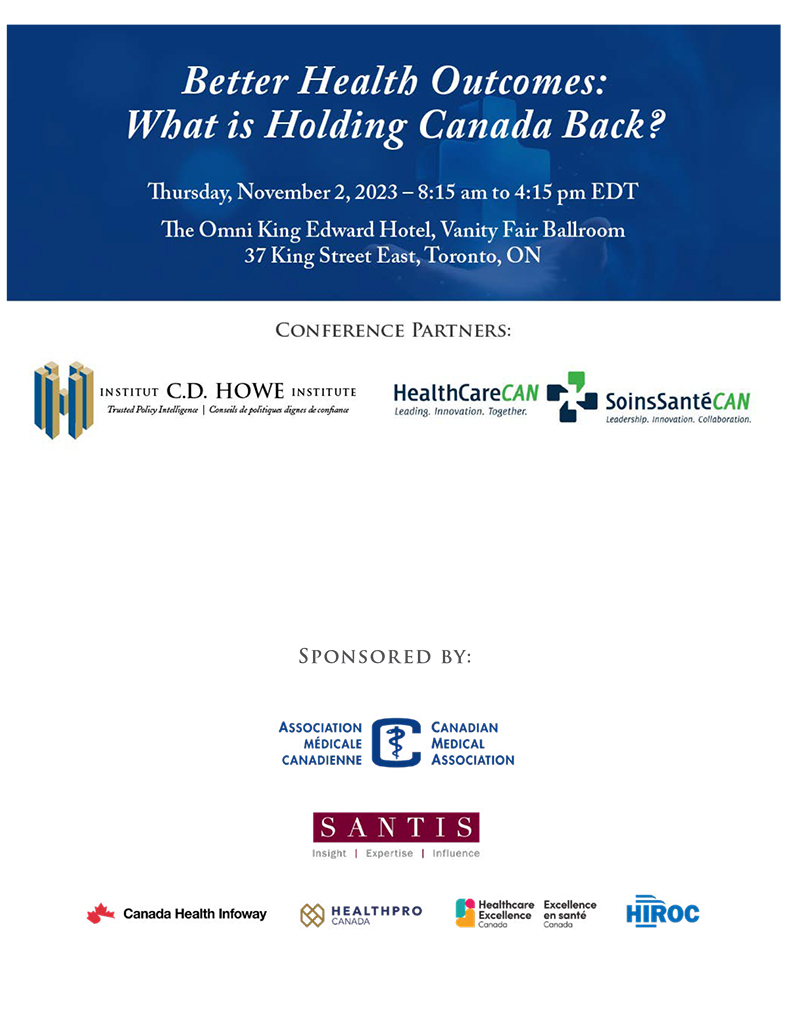
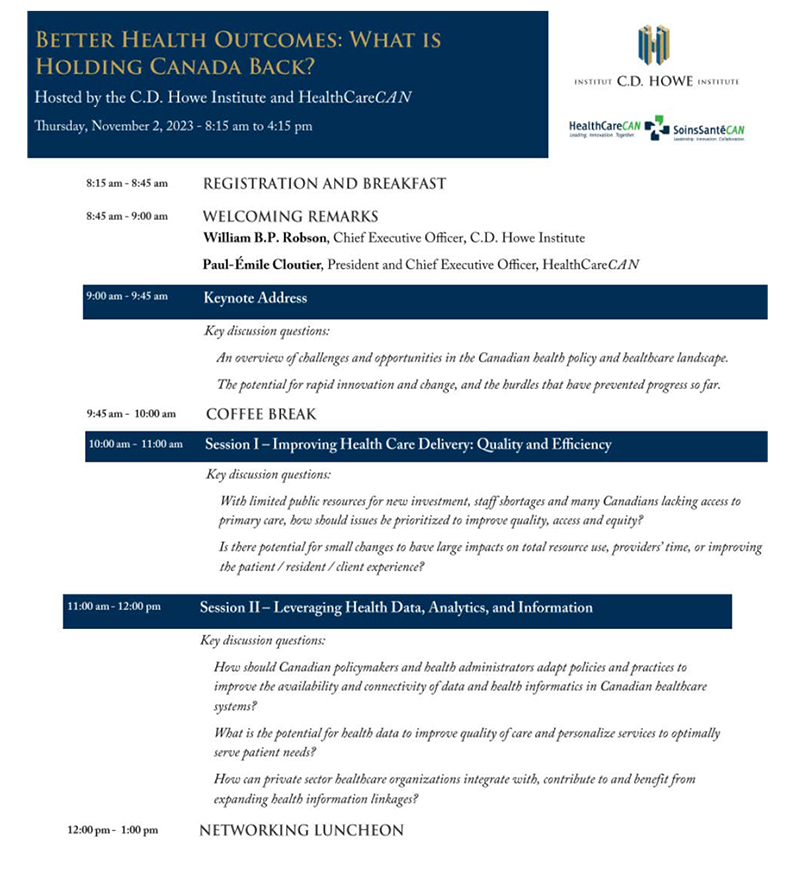
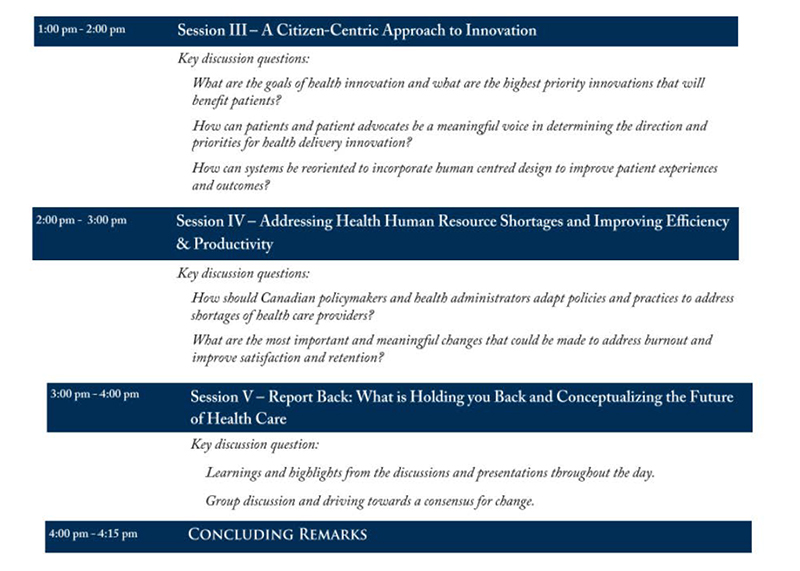
Rapporteur’s Report:
The keynote presentation delved into the overall theme of the conference: better health outcomes and what is holding Canada back. The speaker provided a high-level overview of the state of Canadian healthcare compared to other countries while noting that the tendency to compare ourselves to the US provides a narrow and overly optimistic view. Examining OECD indicators of health system resources and expenditures shows that Canada’s healthcare system is both expensive and equipped with fewer resources compared to other countries. For example, Canada’s spending on healthcare as a percentage of GDP is higher than that of most OECD countries (Figure 1). Similarly, out-of-pocket spending is higher than the average and accounts for a larger proportion of healthcare expenditures compared to countries such as Germany and the UK. Despite higher expenditures, Canada is well below the OECD average for the number of hospital beds, medical graduates and physicians relative to population size. Overall, the speaker illustrated how Canada’s healthcare system is more expensive but has fewer human and physical capital resources and is less publicly funded than better-performing systems while achieving middle-of-the-road outcomes.
The speaker attributed the lack of hospital beds and shortages of physicians to a lack of investment in new hospitals
High expenses and less-than-stellar outcomes were attributed to a disconnect between funding and outcomes, the growing complexity of healthcare and the inertia of implementing system change. Since the federal government introduced the Medical Care Act in 1966, providing universal coverage for hospital and physician services, much has changed. Technology has advanced; pharmaceutical and medical device interventions have grown in complexity and scope; the methods of compensating physicians and funding hospitals have changed; and public expectations for the care they can expect from the publicly funded systems grow with the availability of new treatments and interventions.
As complexity and cost have grown, taxpayer revenues and government budget constraints have had limited capacity to increase funding and adapt healthcare systems to meet the growing demands of the population. The result is that healthcare must be rationed (implicitly or explicitly), which leads to long wait lists, fewer physicians and hospital beds than we need and incomplete coverage. The speaker highlighted the politicization of healthcare in Canada, with decisions often based not on evidence or medicine, but rather on population-based considerations and political input.
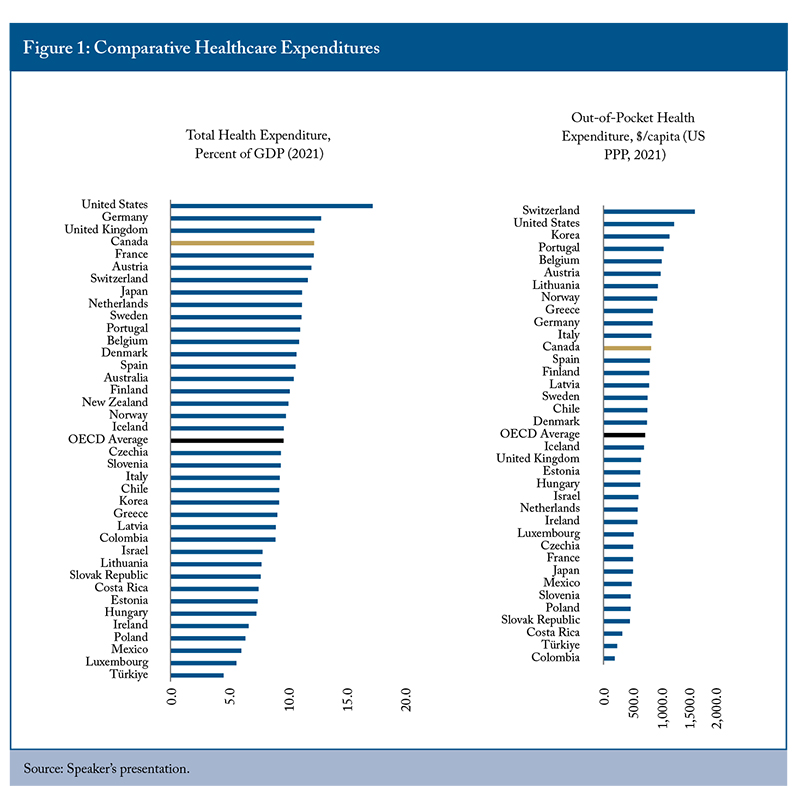
The first step in fixing our ailing healthcare systems is to admit they are broken. The symptoms are clear: challenges in access to primary care, long wait lists for procedures and emergency rooms and maternity wards being shuttered across the country. To address these challenges with more than incremental “Band-Aid” solutions, the speaker called for cultural change around how we think about systemic innovation. The current culture of Canadian healthcare is risk-averse and does not reward politicians, health system managers or practitioners for challenging the status quo and experimenting. In many cases, we think of innovation as a top-down solution or look to technology-based options to improve. While those are important parts of system innovation, the speaker suggested that it should also include removing barriers, experimenting with system funding and practices and empowering and recognizing those who are working to change the status quo or improve processes on the front lines.
Experimenting with new models of providing care or funding the healthcare system is difficult – politicians and providers face significant risk if it fails and have little to gain from success. In the political environment of health policy, any failure can be characterized as a waste of resources and many attempts to change the system can be spun by opponents as leading towards a US-style privatized system. How can you change a system if you are not free to challenge it?
To overcome the inertia and shift towards a culture of innovation, alignment is needed between system decision-makers. The speaker highlighted the importance of understanding how decisions are made within the healthcare system, including who has the power to make decisions and how they use it, as well as how to encourage open debate and manage conflicting ideas.
There’s no one-size-fits-all solution and multiple variables are involved in achieving desired outcomes. System change is not just a political or provincial/territorial issue but rather a complex system influenced by relationships and power dynamics. While simple problems can be solved through planning and acting, healthcare’s complexity requires an iterative approach, learning as you go.
To illustrate a “learning as you go” approach to innovation, the speaker discussed the example of rolling out Patient Medical Homes, which include teams of physicians, nurse practitioners, dietitians, social workers, nurses and other health professionals who will work together with patients to address healthcare needs. No amount of planning ahead of time can incorporate unforeseen gaps or complexities in the execution of the plan in the real world. While tweaking models year-to-year can cause some discontent for central public service ministries with respect to budgeting, adapting as gaps are identified is critical to longer term success. Instead of locking in a model of care and funding, the approach is driven by a clear overall strategy: improve access to primary care, reduce utilization of emergency rooms, and create a “one stop shop” for patient medical needs. Physicians support the team-based model but are not the final word on how the team will be organized.
To manage complexity and adapt the medical home model as it expands, developing constructive relationships between the various providers and decision-makers has been critical. Having more perspectives in the conversation generates ideas that no one group would have come up with on their own. The speaker urged healthcare leaders to encourage advisors and committee members to disagree with them – create a culture of constructive disagreement. This method of innovation and decision-making is different than the traditional “one big fix” health system change that is typical in Canada, such as regionalizing or centralizing decision-making, replacing a CEO, or creating a new administrative body. None of these have been effective at addressing chronic health system challenges: there is no “one big fix.” A more iterative and goal-driven model is being tried through the implementation of patient medical homes.
The speaker then discussed the concept of creative destruction in business and healthcare. A new and innovative idea or product causes market disruption and can be destructive to whatever it replaces. As the idea gains popularity and market dominance, the company and industry grow, but also become less innovative – it’s scary to change from what made you successful in the first place. Eventually, a new product or idea comes along and the cycle repeats. There are examples of this around the world, with the speaker citing Blackberry, Nokia and Kodak. When mature markets fail to innovate, they fall into a rigidity trap. Canada’s healthcare systems are in this rigidity trap – the original social health insurance of the 1960s has not adapted to the growing complexity of population needs and available interventions. The rigidity trap can be overcome through diverse opinions, challenging core beliefs/principles, cataloguing what’s not being done, and freeing up resources for new ideas and innovation.
It is also important to distinguish between minor incremental changes and iterative incremental innovation. The process of establishing medical homes has some immediate benefits, but the longer-term benefits might not be fully realized for decades. Maintaining momentum on a clear strategy can be difficult in a political climate where “quick wins” and “easy fixes” tend to win out over the difficult conversations about existing system challenges and developing long-term strategies to address them. While the “quick wins” can be important, they don’t address core systemic issues.
The speaker concluded by encouraging healthcare leaders across the country to invite diverse voices to decision-making tables and recognize that the narrow view of different stakeholder groups is often self-serving. Encouraging the empowerment of front-line workers and Canadians to demand and suggest system change can counterbalance influence from narrow perspectives and provide the political support to encourage broader and bolder innovation.
Session 1: Improving Healthcare Delivery: Quality and Efficiency
The first speaker in this session highlighted recent successes in changing healthcare delivery and improving quality in their province. The province’s healthcare system faces many of the same challenges as other provinces: a large and growing portion of the population is over 65 years of age, there are high cancer rates in the population, urban/rural divides, and limited public resources for improvement. Despite the challenges, the speaker highlighted quality improvement units in hospitals, health innovation hubs, establishing a province-wide command centre, and expansions in virtual care as examples of innovation and improving access in healthcare. According to the speaker, one of the most critical factors in recent progress has been a streamlining of decision-making, collaborative leadership and having support from government.
The speaker also encouraged looking for good ideas both domestically and from abroad – there’s no need to reinvent the wheel when it can be imported and adapted for the Canadian environment. For example, the speaker referenced the health innovation challenge, an idea imported from Singapore. Frontline staff have the opportunity to submit one or more “common sense ideas with a focus on improving healthcare.” All ideas were eligible for a random draw and a review panel short-listed ideas to be developed into priorities for implementation. This challenge is a low-cost way of generating many potential ideas for improvement. It gives front-line workers an opportunity to bring ideas forward, has expert oversight in shortlisting the potential solutions and has built-in public input through voting to select priorities, which provides backing to the political will for implementation. Local advantages can also be leveraged for innovation. The speaker urged investing in learning and leveraging university research and start-up culture for health system improvement. The speaker noted that their province has a strong life sciences and biomanufacturing sector, particularly in medical devices.
The speaker also discussed investing in core health system infrastructure to support innovation and quality improvement. For example, Nova Scotia has invested in software to create a province-wide command centre that can provide health administrators and clinicians with real-time information about hospital capacity utilization, flag potential problems and inform process improvements. Patients can access new innovative treatments and technologies to improve care through advanced clinical trials, and clinical trials can provide evidence for local effectiveness and outcomes. The speaker noted that Nova Scotia is the first place in the world to acquire the Ethos radiotherapy system with Hypersight imaging, following a clinical trial conducted in the province.
The Ethos therapy system is made by Varian, a Siemens Healthineers company. Early data from a 30-patient study, supported by Varian and executed by Dr. James Robar and colleagues through the Nova Scotia Health Innovation Hub, were published just this month, demonstrating that Varian’s HyperSight technology can generate, in six seconds, the kind of high-quality images needed for daily adaptation of a radiotherapy treatment plan based on changes, over time, of the patient’s tumor and surrounding anatomy. (Source: https://www.nshealth.ca/news-and-notices/nova-scotia-health-and-varian-…) The speaker also noted the expansion of virtual care and walk-in clinics in have improved access to primary care for those who don’t have a family doctor.
Sharing and collaborative leadership, supported by the provincial/territorial government, is the secret to making rapid and meaningful health system changes, according to the speaker. With only one health authority, few layers of management for decision-making and support from politicians empowered by a strong mandate from the public, rapid innovation is possible and is having real impacts for patients in the province. The speaker acknowledged that these are particularly favourable conditions for system innovation and understood why many leaders might settle for less than the best.
When implementing changes is frustrating, gets bogged down in layers of managerial approvals, and there are no direct incentives to encourage innovation, it can be easy for leaders to become complacent. Changes to the political climate or governing party can also cause disruption to health improvement strategies. When resources are stretched, many health leaders will be obliged to spend the majority of their time on maintaining operations, leaving little room for experimenting and investing in improvement. The speaker noted that the streamlining of decision-making and the ability to rapidly test, implement and iterate solutions is helping to improve care in Nova Scotia today and is contributing to building a culture of innovation.
The second panelist’s presentation contrasted with the optimism of the first speaker, by focusing on three chronic diseases in Canadian healthcare systems: access, structure, and parasitic loss. The speaker noted that 19 percent of Canadians don’t have a family doctor and 29 percent have chronic difficulty in accessing care. They noted that family medicine residencies are the most likely to go unfilled and fewer medical graduates are choosing family medicine. Meanwhile, internationally trained medical graduates (IMGs) have difficulty accessing residency positions or obtaining licences to practice in Canada. Reducing barriers to licensure and training for IMGs, reforming the incentives to encourage physicians to practice family medicine, and reducing unnecessary administrative work or capital expenditures associated with practice could increase the number of primary care practitioners and help address this chronic access challenge.
Turning to structure, the speaker highlighted various studies and data to illustrate that restructuring through regionalization or centralization of the health authority is not a magic pill to fix the healthcare system.
The third chronic disease of the Canadian healthcare system, according to the speaker, is “parasitic loss,” an engineering concept referring to the power that an engine requires to operate itself. The parasitic losses in Canada’s healthcare systems are large geography with low population density; restrictive or burdensome software; destructive cultures; a lack of competition; and inefficient and overly bureaucratic systems. The speaker noted that centralized decision-making can sometimes increase parasitic loss by forcing an inefficient standard. A single solution can be more administratively simple and may have benefits for standardizing and amalgamating data. However, by sourcing from a single supplier, innovation becomes limited to a single company in the long run. The speaker echoed the previous panelist by highlighting that inefficient and overly bureaucratic systems can stifle innovation by creating frustration and complacency amongst health leaders that want to implement improvements. Similarly, a culture that does not reward innovation reinforces the status quo. The speaker suggested that encouraging innovation and competition in the delivery of healthcare, selection of technology, and tools to provide care, would likely increase quality and reduce costs in the long run.
The final panelist started their presentation by noting that Canadian health policy and its ideology have a deeply ingrained bias against competition. They suggested that, ironically, many people in the waiting room of a private medical clinic would say that “two-tier” healthcare is a bad thing. The speaker disagreed and stated that competition from the private sector is good for healthcare and that governments won’t always make optimal choices. The private sector and competition can provide the mechanism for continuous innovation by finding efficiency and improving quality to maintain customer bases.
As an example of non-optimal decision-making, the speaker discussed the invention of telehealth in the US in the 1990s. The first telehealth company, MDS, was a service sold to hospitals and would direct a high volume of people to seek hospital care for their ailments. A second company “Access Health” was used to triage people away from hospitals and was sold as a service to insurance companies. When the Ontario government put out a Request for Proposals for a telehealth provider, there were no criteria for triage methods, only for costs. The telehealth company that directed callers to seek hospital care was less expensive per call than the one that triaged patients away from hospital emergency rooms with the potential to reduce ER demand and improve capacity The speaker said that the higher cost per call of the telehealth provider that triaged people away from hospitals and the lack of consideration for hospital capacity in the request for proposals meant the other telehealth provider was chosen. If governments evaluate purchases without including comprehensive quality and cost criteria, they make non-optimal purchases. There is a need to move beyond paper-based applications to technology platforms for procurement and purchasing.
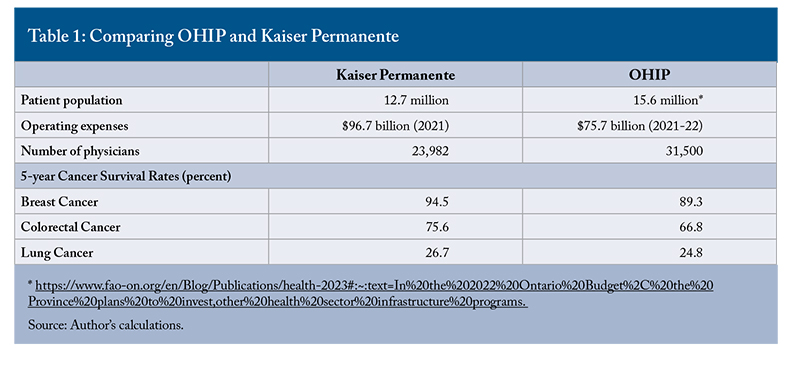
To illustrate the public benefits of private competition, the speaker referenced Kaiser Permanente in California.
To address the challenges in Canadian health systems with limited public resources for new investment, the speaker concluded that competition is a powerful mechanism to align incentives with outcomes and drive innovation. To introduce competition, particularly from private entities, we need strong and accountable leadership from government, the public service and leaders of health organizations/institutions. Private organizations respond quickly to changes in markets compared to bureaucratic central decision-making.
Session 2: Leveraging Health Data, Analytics and Information
The panel discussion featured three speakers who provided valuable insights on various aspects of health data, information, and infrastructure. The speakers underscored the importance of digital tools in healthcare, acknowledged challenges like digital burnout and system fragmentation, and expressed optimism about the increased national interest in healthcare and the ongoing efforts to standardize data and address cybersecurity issues. Their focus is on making effective use of digital systems to improve healthcare outcomes in a collaborative and standardized manner.
The first speaker emphasized the importance of collaboration and agreeing on best practice standards to achieve interoperability and scale in health data endeavours. They shared examples from their own experience and discussed how working together with colleagues and partners can lead to better results. They also highlighted the role of communication and trust in building successful collaborations. That speaker also focused on the clinical use of data and how digital tools, facilitated by organizations like Canada Health Infoway, aim to enable healthcare providers to deliver more effective care. They acknowledged the issue of digital burnout among nurses and doctors due to the time-consuming process of populating electronic health records (EHRs) and electronic medical records (EMRs) with data. They stressed that the investment in digital systems should not merely result in electronic filing boxes but should contribute to efficiency, effectiveness, quality, and accessibility of healthcare. They highlighted the need for these systems to provide a tangible payback in terms of improved healthcare outcomes.
The speaker acknowledged the reality of and challenges in a fragmented health system – for example, the continued use of paper-based referrals or prescriptions limits accessibility and interoperability – emphasizing the need for modernization throughout the healthcare system to enable standardized, accessible, and transparent health information and data. Despite challenges, the speaker expressed optimism about the growing priority given to healthcare within policymaking.
The speaker highlighted and described the role of their organization as one that facilitates cooperation and brings partners together. There is a need for standardization, especially in collecting and sharing data, for the benefit of care provision and research. The goal is to encourage interoperability across the country, focusing on standardizing data collection and sharing.
The speaker acknowledged that a tremendous amount of effort is needed, not just around technology but also in terms of adoption and best practices, to standardize the collecting and sharing of data across the country. However, there is ongoing investment in EHRs across the country and the speaker emphasized the responsibility to make proper use of these systems for the benefit of taxpayers and improved healthcare outcomes. There is an increased focus on healthcare, particularly after the COVID-19 pandemic, with provincial/territorial elections hinging on healthcare issues. Policymakers are actively looking at ways to improve healthcare systems and make smart use of digital technology.
The second panelist focused on the need for innovation, the role of the private sector in housing and managing health data for their own operations, and the potential to leverage these data repositories for insights. They also stressed the importance of testing and refining new ideas before committing to standards. The speaker highlighted the increasing pressure points and complexity in the healthcare system, particularly with the growing number of highly specialized therapeutics, leading to cost pressures and evidence-based challenges. They discussed the evolving landscape of care delivery, emphasizing the diverse ways in which healthcare services are organized and delivered globally. Similarly, the expansion of scope of practice and the involvement of various professional groups in delivering patient care adds complexity to healthcare data interoperability and evidence collection. This rising complexity implies challenges in understanding real-world impacts and building evidence cases for the use of therapeutics.
The speaker addressed the challenges of data interoperability, especially with the need to extract data from diverse sources, including pharmacy systems and private care corporations, and raised concerns about the potential risk of turning large data repositories into cumbersome and ineffective data swamps with traditional legislative approaches. The speaker advocated for a new approach to data infrastructure that allows data to remain where they sit while enabling the assembly of different datasets on-the-fly to answer specific questions. The speaker acknowledged the growing challenges in ensuring the safe, appropriate, and ethical use of artificial intelligence, large-language models, and neural networks. They recognized the ongoing role of innovation in dealing with the sensitivity and ownership of data, particularly in the context of AI applications. They suggested adapting current policy towards the development of a more collaborative, but potentially also more unstructured approach to building out data infrastructure.
The final speaker discussed the role of politics and reflected on power dynamics in public-sector systems. They expressed encouragement for steering away from governance systems with top-down decision-making and minimal opportunities for including diverse voices at the decision-making table. They advocated for an increased focus on digital patient experience and engagement in the realm of digital health. There is a role for policymakers to define digital patient rights, reconsider funding systems, and publicly report on the performance of healthcare organizations regarding digital patient experience. The concept of patient rights should extend beyond privacy concerns to include enabling rights. For example, to access health information easily, engage with healthcare providers virtually, receive remotely delivered health services, and use personalized digital health companions.
The speaker stressed that trust is a critical factor in public services, more impactful than expertise This challenges the conventional notion that expertise alone is sufficient and highlights the crucial role of trust in building strong relationships with patients. Patients will judge the trustworthiness of the healthcare system based on their digital experiences. With a forward-looking perspective, the speaker predicted that, by 2030, successful healthcare organizations will predominantly meet patients in the digital universe and make patients the undisputed leaders in their care journey, reflecting a shift towards patient-centric healthcare models. They warned that failure to embrace this shift may lead to challenges such as patients seeking misinformation and a loss of faith in healthcare leaders.
Despite the challenges, the speaker expressed optimism about the capacity to manage the opportunities and challenges in digital health. They acknowledged the outstanding job done by the digital health community in building a solid infrastructure over the past 20 years. They encouraged a shift from an inward-facing approach to digital health infrastructure to a patient-centric design and emphasized the importance of building tools that prioritize making patients healthy, happy, and trusting of the healthcare system. They concluded with a reminder that digital health systems should be built for patients’ well-being and trust, not for self-indulgence or impressing experts in the field.
During the discussion, panelists acknowledged the benefits of not reinventing the wheel and sharing best practices in digital health. They noted that there should be an emphasis on patients being drivers of the healthcare system, and that patients know what features they want. However, they may not fully grasp the associated risks and challenges from a data security perspective.
Discussion ensued on the challenges of accessing timely health information, with a focus on the difficulty of obtaining real-time data from centralized systems. The need for legislation to address patient access rights and regulate the free exchange of data was recognized, with a mention of ongoing efforts by Health Canada.
A participant asked about the role and potential contributions of the private sector in resolving healthcare data issues. In response, a speaker recognized the private sector’s role in building digital health solutions and the need for early involvement in system design discussions. The discussion continued on the benefits of consuming innovation from the private sector, bringing in external expertise, and forming partnerships between private and public sectors.
Overall, the panelists shared optimistic views on the potential for system transformation through patient-driven initiatives and the utilization of private sector innovations. In addition, there was recognition of the shift in public perception regarding the role of the private sector in healthcare, citing examples of successful collaborations that brought economic benefits and jobs. However, a speaker also acknowledged the challenges in the Canadian healthcare system, such as slow adoption and the gap between digital visions and current clinic operations. They called for a systematic approach, mentioning legislative efforts and the need for a shift in public mood to support changes.
In their closing thoughts, the speakers encouraged focusing on success stories, highlighting the significant improvement in data accessibility. They acknowledged the importance of public and private collaboration, with a call to make partnerships economically sustainable and beneficial for both sectors. The discussion had an unexpectedly optimistic tone, with panelists highlighting ongoing positive efforts, successful examples, and the potential for collaboration between the public and private sectors to drive innovation and positive changes in the Canadian healthcare system. There was a recognition of challenges, but an overall belief in the transformative power of technology and patient engagement.
Session 3: A Citizen-Centric Approach to Innovation
The panelists’ discussion of a citizen-centric approach to health innovation contrasted different approaches that can be taken at different levels of the system. The speakers highlighted systemic and incremental strategies for improvement. The first speaker began by addressing challenges in the Canadian healthcare system, drawing attention to poor performance compared to other Western countries despite high spending. They argued that the problem lies in the structure of the system rather than a lack of funding. Specifically, they criticized the focus on volume-based metrics (such as the number of procedures) rather than outcomes, suggesting that the structure needs fundamental changes to achieve better results.
That speaker discussed the need for a specific focus on “citizen-centric” healthcare, as they believe healthcare should inherently be centered around citizens. They criticized existing approaches that may be politician-centric, bureaucratic-centric, and doctor-centric. They highlighted the uniqueness of Canada’s almost entirely publicly funded healthcare system and expressed concern about the independence of physicians [with respect to how they run their practices and the lack of coordination and linkage between different practices], suggesting that this needs to be addressed for any significant improvement in the system. In other countries with publicly funded healthcare, there are more mechanisms that provide transparency and accountability, such as publicly reporting wait times, service volumes, and providing incentives for desired performance. There are also examples of these mechanisms being better leveraged to make the healthcare system citizen-centric. For example, Scotland has a “Health and Care Experience Survey” that is conducted annually and shows how well general practitioners are meeting the needs of the population.
The speaker then discussed innovation in healthcare, defining it as a response to unmet needs. They argued that innovation in healthcare should come from the “trenches” where unmet needs are identified. They reject the idea that innovation should be directed by the government, emphasizing that it often originates from those directly involved in healthcare delivery. The speaker also touched on the concept of disintermediation, the removal of intermediaries, advocating for a shift toward a more citizen-driven model where individuals have greater control over their health. Throughout the discussion, the speaker shared examples of how the status quo can slow down adoption and innovation in care delivery, in particular highlighting physician remuneration and training. For example, the speaker highlighted the need for remuneration to recognize new modes of virtual care delivery and importance of training physicians in the Canadian healthcare system, particularly in light of the pandemic. They expressed frustration with the medical curriculum for not incorporating virtual care training, despite the need for graduating students to be prepared for that mode of practice. They also mentioned the Cleveland Clinic and the International Consortium of Health Outcome Metrics as noteworthy references.
The next speaker began by emphasizing the importance of adopting new perspectives and asking different questions for better health outcomes. They shared their personal experiences of feeling stifled by the traditional and structured approach in medical school. They advocated for creative problem solving and empowering practitioners and front-line workers to improve patient experiences. The two mindsets the speaker considers crucial for designing better health outcomes are being citizen-centric and having a creative mindset.
To have a citizen-centric approach, the speaker emphasized the need to seek input from the people one is designing for, emphasizing the importance of understanding their wants and needs. They emphasized the importance of involving patients and people as experts in their own experiences. They shared examples of using semi-structured interviews and informal conversations to understand people’s needs and design better solutions. For example, the chaotic and unfamiliar environment of an emergency department can be overwhelming for autistic children. Interviewing parents and understanding the difficulties led to the creation of a solution: a cart with toys and distractions tools that can be in the waiting room and follow them to treatment rooms giving autistic children something familiar to focus on to make the experience of receiving medical treatments less daunting.
To illustrate the power of activating a creative mindset, the speaker got participants to do an exercise they regularly use in creative-thinking workshops. The simple exercise consisted of two activities: draw a bridge and draw a creative way to cross a river. In these workshops, participants are often overworked and tired, but the speaker aims to show them that they are creative thinkers who can find innovative solutions to healthcare challenges. For the first exercise, people predictably draw bridges. For the second, people draw everything from catapults to rocket ships. The problem these solutions solve is the same: cross the river, but the solutions can be drastically different, depending on the mindset employed to solve the problem. The power of creative problem solving is that it can reframe the problem, and the possible solutions, in ways that would not be obvious working within existing structures.
The speaker discussed the power of a creative mindset and the technique of prototyping, a fast and inexpensive way to test ideas and gather feedback. They shared an example of addressing confusion in the emergency department by creating and continuously iterating on signage. The process involved informal feedback and observations, leading to an effective and low-cost solution.
The speaker concluded by stressing the challenges of maintaining creative confidence in healthcare settings, where proposing new ideas can be difficult. They emphasized the need to empower front-line workers to make small innovations, remove unnecessary barriers, and identify more exciting ways to address healthcare challenges. The overall message was a call to foster a culture of innovation and openness to improve healthcare outcomes.
The discussion following the presentations revolved around the need for all stakeholders, from healthcare providers and suppliers to patients and citizens, to adopt a creative mindset in healthcare. Collaboration, understanding unmet needs, and empowering individuals at all levels are seen as critical components of an innovative and effective healthcare system.
A question about higher level systemic innovations led to highlighting innovations in the health system – in particular, the hospital-at-home program initiated during the fifth wave of the pandemic. The program started as a COVID at Home initiative and has expanded to include various clinical trajectories, including recovery and surgical patients. Microsoft HoloLens is now integrated into the program to address manpower shortages.
A question was raised about the how to address the current crisis in emergency care in Canada. One of the speakers suggested using technological tools, such as AI, to provide patients with control and information about their care. The other shared their experience of sleeping in the hospital for a week to understand the dynamics of the emergency department and address acute challenges. The changes resulting from their observations and in how people worked resulted in a less crowded emergency department and in technology that improved efficiency and redirected some patients to other avenues of care, if they were available. However the discussion also touched on the need to find ways for patients to be seen where they need to be seen in a cost-effective and safe manner. Both speakers emphasized the role of primary care in preventing emergency department overcrowding.
Session 4: Addressing Health Human Resource Shortages and Improving Productivity and Efficiency
The first speaker reflected on their extensive career in health systems and workforce planning. They acknowledged the collaborative efforts with experts in various fields, such as health economists, demographers, and epidemiologists, and academics. The focus of their work has been on developing a needs-based planning approach to health systems and clinical workforce planning.
The speaker’s central argument revolved around the need to shift the focus from merely increasing the number of physicians and nurses to addressing the actual needs of people. They stressed the importance of understanding individuals’ health status, social determinants of health, and other factors to determine the type of care required. The speaker criticized the persistent emphasis on supply-based models and highlighted the necessity of utilizing data effectively for informed decision-making.
The speaker drew attention to the challenges in implementing effective strategies due to political and technical factors. They pointed out the historical trend of attention to workforce shortages during crises, only for the focus to diminish afterward. The COVID-19 pandemic was mentioned as a catalyst for change, emphasizing the importance of partnerships and innovative approaches.
Several examples were provided to illustrate successful initiatives, including collaborations between nurse practitioners and pharmacists, data-driven decision-making using platforms like MDClone,
The speaker highlighted initiatives like international recruitment partnerships with countries such as India and the Philippines. They emphasized the need for a cultural shift and effective change management to implement these innovations successfully.
In conclusion, the speaker remained optimistic about finding solutions to health workforce challenges and making a positive impact. They stressed the importance of learning from both successes and failures and fostering a culture of innovation in healthcare.
The second speaker focused on physicians and proposed a four-point strategy that aims to tackle the shortage of physicians and alleviate burnout. The speaker emphasized the need for a nuanced approach to improving efficiency and productivity and urged against a single-minded focus on increasing capacity. Instead, they advocated for creating breathing room for health professionals, including doctors and nurses. They stressed the significance of information utilization and maintaining a focus on the end user, echoing points made by earlier speakers.
Regarding the first strategy of sharing the load, the speaker identified the lack of access to primary care as a major healthcare challenge affecting millions of Canadians. They presented compelling data indicating a significant shortage of family physicians and argued that family doctors alone cannot address this issue. The speaker advocated forcefully for expanding team-based primary care, citing ongoing challenges related to the interpretation of insurance services under the Canada Health Act.
The second strategy involved embracing technology, where the speaker acknowledged the historical role of Canada in pioneering telemedicine. However, they highlighted the unfinished business related to asynchronous care and the untapped potential of technologies like AI in clinical care. The mention of AI-powered digital scribing as a potential application underscored the speaker’s forward-looking approach.
Reducing administrative burden is the third strategy, and the speaker underscored the challenges posed by forms and electronic medical records (EMR). The burdensome nature of paperwork and EMR is identified as a source of burnout, and the speaker cites survey data and initiatives such as the Health Care Unburden Grant Program which offered $10 million in grants for initiatives that reduce administrative burden for physicians.
The fourth strategy involves advocating for pan-Canadian medical licensure. The speaker provided concrete examples of how this can address physician shortages, especially in rural and remote locations, and facilitate virtual consulting services. The launch of the Atlantic registry is highlighted as a positive step towards streamlining licensing processes.
The speaker concluded with a cautionary note, expressing concerns about a potential return to old working practices as the pandemic recedes. This detailed and multifaceted discussion underscored the complexity of the challenges in the healthcare system and proposed a strategic approach to address them comprehensively.
The final panelist shared insights into the challenges and successes of addressing healthcare and human resource issues. The speaker emphasized the importance of understanding the magnitude and scope of healthcare workforce problems, particularly the dissatisfaction among staff.
Surveys of worker satisfaction offer a mix of good and bad news. On the positive side, healthcare workers feel they provide excellent care to the people they serve, validated by quality indicators and client responses. However, the bad news is the significant dissatisfaction among staff across various professions and care settings, stemming from burnout and a lack of recognition.
To tackle this, the speaker introduced the concept that “employee experience equals client experience.” They emphasized the need for a shift in focus to address the employee side of the equation. The three key strategies to improve employee experience are flexibility and choice, talent intelligence, and rewards and recognition.
The speaker highlighted the challenges faced by staff, especially in roles like PSWs, who often lack flexibility in scheduling. To improve flexibility and choice, they introduced a flex program aimed at giving staff more control over their schedules, allowing them to choose shifts that align with their skills and preferences. Another aspect involves addressing payroll cycles to ensure timely compensation for extra shifts.
The second strategy, talent intelligence, involves partnering with startups to leverage AI and innovative platforms for better recruitment processes. The goal is to match individuals with the right competencies to specific roles more effectively, reducing turnover and improving employee satisfaction.
The third strategy, rewards and recognition, introduces an app-based system where leaders can reward staff with stars based on values and actions aligned with the organization’s goals. These stars accumulate and can be converted into rewards, with a unique long-term plan of converting them into a form of equity for PSWs. The speaker encouraged the audience to take action in their organizations, emphasizing the importance of recognizing and addressing the needs of the healthcare workforce.
The discussion portion of the session started with a question about an innovation program related to health human resources. The focus was on how innovation can engage staff and drive cultural change within the healthcare sector. The speaker mentioned initiatives like the campus-link health accelerator program, collaboration with private industry partners, and programs supporting innovators in residence. The discussion emphasized the importance of changing the culture within the healthcare sector to encourage and reward innovation.
The conversation shifted to addressing the shortage of doctors in Canada. The speaker questioned whether the gap can be closed and discussed the challenges, including the long timeline for creating new medical professionals and the need for innovative solutions like virtual care. The panel also explored the role of homecare providers in addressing healthcare gaps and improving patient outcomes.
The audience raised a question about licensing challenges for healthcare professionals, particularly those immigrating to Canada. In response, panelists suggested a need for a shift in the assessment process, valuing prior learning and experience, and streamlining onboarding processes. The discussion concluded with an acknowledgment of persistent challenges in healthcare human resources and the importance of ongoing innovation to address these issues.
Session 5: What’s Holding You Back and Conceptualizing the Future of Healthcare
The final session of the conference involved surveying participants on their views on the key takeaways from the day, the most impactful ideas for change, and what questions remain unanswered.
A common theme among the survey responses on key takeaways was enthusiasm for innovation, with acknowledgement that shifting to an outcomes-based and citizen-centric health system will require increasing risk tolerance amongst health leaders and empowering change from the status quo.
The participants noted the positive examples of rapid and successful change across the country and the constructive role of collaboration between health decision-makers and political leaders empowered by their electorates. There was some discussion of the role of politics and how it can accelerate positive change in some circumstances, while in others, it can be a barrier due to the complexity of the system, an entrenched risk-aversion to change, competing mandate priorities and four-year election cycles.
Though many participants highlighted the power of effective leadership, others pointed out that the status quo is likely to remain unless health human resource challenges are addressed and the incentives that drive leadership decisions are changed to align with a more risk-tolerant and innovative health system.
Participants also highlighted the challenges in effectively linking patients and front-line practitioners with higher level decision-makers and a lack of mechanisms to scale successful system improvements. Multiple participants highlighted the positive role of the private sector and competition as a mechanism for innovation and increasing capacity to deliver care. There was also disagreement among participants about the direction for change: within the system or more fundamentally revolutionary?
Participants’ responses on the ideas that would be most impactful for change show some common priorities. Among the most frequently mentioned impactful ideas are:
- Engaging Canadians in the required policy-making discussions on how to transform healthcare systems to better incorporate competition within the public healthcare system and more effectively and equitably integrate private healthcare delivery, insurance and financing options.
- Aligning incentives across the system with improved health outcomes. Included among these ideas are: shifting from measuring outputs based on costs and volumes to improved health outcomes, addressing physician remuneration, actively embracing allied health services as health partners and expanding scopes of practice, improving accountability and responsibility of decision-makers, and focusing effort to engage staff at all levels and empowering them to implement improvements – in short, design the system to create a culture that rewards innovation and aligns provider incentives with better health outcomes.
- Empowering patients/clients to demand the outcomes that matter most to them by improving accessibility and transparency of data, educating them about health and wellbeing, and introducing meaningful competition in service delivery.
- Increasing prevention efforts and improving accessibility and equity to improve population health and reduce the demand for more advanced healthcare services over the long term. Included among these ideas are increasing public health education and expanding health teams and virtual care to reach under-served populations.
- Improving data accessibility and linkages for coordination of care, patient empowerment and reducing administrative labour for practitioners. It was also noted that this will be critical to future AI-based technologies to improve health and reduce labour.
There were also some responses that added nuance to ideas discussed throughout the day. For example, some participants suggested ways to reduce the tension between standardization and experimenting with new technologies, and the distance between front-line workers, patients and decision-makers. One participant advocated for allowing for competition within the publicly funded system and finding the areas where arm’s-length decision-making is most beneficial and sustainable. Another added that the benefit of standardization is the ability to scale best-practices across the system. If a best-practice becomes clear, standards can force adoption throughout the system. However, when considering new technology, end-user needs should be the deciding factor and centralized decision-making can be detrimental if those needs are not well understood. These responses suggest that there is a role for both arm’s-length decision-making and centralized standards in the health innovation ecosystem – competition and experimentation test new technologies and standards can help to scale the most beneficial ones and provide common ground for comparison of different approaches.
The final discussion of the conference was on next steps and questions that remain unanswered as to how to address the top priorities. A key question amongst the participants was how to activate and empower the public and inform, en masse, about the significant challenges Canada’s healthcare system is dealing with and the potential consequences of failing to act.
There was also a desire for a deeper understanding of the enabling factors that need to be put in place to empower decision-makers to drive change. With many challenges and many priorities, the areas with the highest potential for change are those that matter to patients and elected representatives, as well as the health workforce that delivers healthcare. Given how Canada’s healthcare system compares to OECD countries, participants also urged looking to successful international examples that could be adapted and implemented in the Canadian context.
References:
CIHI. 2023. “Resilient health work force key to pandemic recovery. Taking the pulse: A snapshot of Canadian health care.” https://www.cihi.ca/en/taking-the-pulse-a-snapshot-of-canadian-health-care-2023/resilient-health-workforce-key-to-pandemic
CIHI. 2020. “How Canada Compares: Results from the Commonwealth Fund’s 2020 International Health Policy Survey of the General Population in 11 Countries – Data Tables. “
Department of Managed Health Care. 2023. DMHC, “Kaiser Permanente Reach Settlement Agreement to Transform Plan’s Behavioural Health Care Delivery System and Improve Behavioural Health Statewide.” https://www.dmhc.ca.gov/AbouttheDMHC/Newsroom/October12,2023.aspx
Health at a Glance 2021. https://www.oecd-ilibrary.org/sites/e5a80353-en/index.html?itemId=/content/component/e5a80353-en#:~:text=Over%20half%20of%20OECD%20countries,in%20nearly%20all%20OECD%20countries.
Kaiser Permanente. 2023. “Median Appointment Wait Times for the State of Maryland – September 2023.”
https://healthy.kaiserpermanente.org/content/dam/kporg/final/documents/forms/median-wait-times-for-mas-en-2023.pdf
McCormick, J., and L. Longero. 2023. “Best Health Insurance Companies.” https://www.insure.com/best-health-insurance-companies/
Attendee List:
Frédéric Abergel
Owen Adams
Jason Bilsky
Jessica Brcko
James Brodie
Brigid Buckingham
Dan Carbin
Craig Ceppetelli
Mauro Chies
Paul-Émile Cloutier
Janet Davidson
David Diamond
Christine Donaldson
Sarah Downey
Tim Duncanson
Brynne Eaton-Auva’a
Alison Forestell
Shaun Francis
Neil Fraser
Robyn Fulkerson
Michael Gardam
Catherine Gaulton
Brian Golden
Michael Green
Simon Hagens
Mike Hamilton
Rosemary Hannam
Graham Hay
David Hill
Greg Horne
Angelica Kakridas
Jennifer Kitts
Hal Koblin
Glenn Lanteigne
Geneviève Lavertu
Christopher Lawson
Sasha Litwin
Nelea Lungu
Bonnie Lysyk
Rob MacIsaac
Kathy MacNeil
Adi Malev
Dylan Marando
Robert McKay
Jonathan Mitchell
Saurabh Mukhi
Christopher Naugler
Patrick Nelson
Matthew Norton
Marilee Nowgesic
Karen Oldfield
Valerie O’Neill
Lucie Opatrny
Marissa Persaud
Bill Robson
Michel Rodrigue
Lawrence Rosenberg
Zahid Salman
Karey Shuhendler
Nadiya Sunderji
Gail Tomblin Murphy
Tammy Trepanier
Harvey Weingarten
Joan Weir
Steve Wharry
Victoria Wiebe
Rosalie Wyonch
John Yip
Jennifer Zelmer
Tingting Zhang





